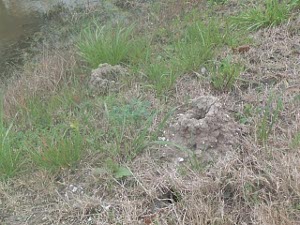 Louisiana fishing boats
Louisiana fishing boats
Crossing the Sabine River is one of the most vivid cultural changes in the U.S. -- from Texas to Louisiana. It's hard to pin down, too, but it's evident to the traveler. Probably the clearest indicator is the change from dry to wet.
 Louisiana fishing boats
Louisiana fishing boats
While it's true that East Texas is wetter than West Texas, nevertheless Louisiana is the wettest part of the U.S. With an annual rainfall of 120 inches, it's wetter even than the Pacific Northwest. Especially in Southern Louisiana, water is everywhere: canals, rivers, lakes, swamps. The bayou -- water surrounding patches of low grass and swampland -- surrounds the roads on all sides. Wherever the ground is firm enough, cattle and goats graze.
We continue to learn about the oil business: a friend reports that the inactive oil wells we noted in Texas are probably on timers because they are only allowed to pump a certain number of hours each day. It's clear there's more to this than meets the eye!
The French influence in Louisiana is palpable; it has proven to be much more enduring than the various ethnic influences on Texas. The Texans of  Crawfish homes
German or Czech ancestry became Americanized, or at least Texanized; the Acadians who ended up in Louisiana brought a culture which has triumphed, at least in its home region of southwestern Louisiana. It's obvious in the names on mailboxes and shops, and on the occasional bi-lingual billboard or road sign. We wonder whether the above-ground cemeteries are a French custom, as well as a protection against the water-logged ground.
Crawfish homes
German or Czech ancestry became Americanized, or at least Texanized; the Acadians who ended up in Louisiana brought a culture which has triumphed, at least in its home region of southwestern Louisiana. It's obvious in the names on mailboxes and shops, and on the occasional bi-lingual billboard or road sign. We wonder whether the above-ground cemeteries are a French custom, as well as a protection against the water-logged ground.
We chose to drive due south out of Sulfur, Louisiana, on highway 27, and then east on highway 82. As we crossed bayous and waterways and skirted huge lakes, waterfowl were everywhere: aside from the familiar herons and egrets, coots and cormorants, stilts and pelicans, we saw roseate spoonbills and laughing gulls, and were happy to check them off in our Sibley.
We also saw the evidences of more watery land-creatures, such as crawfish houses, turtles, and alligators, three of whom seemed to be right next to us as we walked the nature trail in the Sabine Wildlife Refuge.
 Hardhat birdhouse
Hardhat birdhouse
Texas gives the impression of being nearly completely explored in the search for oil, but the oil exploration industry in the Gulf off the Louisiana coast seems to be dynamic and a major force in the regional economy. Many cars were parked at the boat docks and helicopter fields where workers are ferried out to sea to work on the oil rigs, and many businesses which support oil drilling are in evidence near the coast.
Of course shrimping remains a major gulf industry, and many of the towns we drove through had harbors filled with shrimp boats. Little towns are filled with signs in Magic Marker pointing to sheds or tiny shops: Hot Crawfish! Boiled Crawfish! Shrimp Here!
As for agriculture, the changes were evidenced by rice paddies and sugar cane fields, and different breeds of cattle which were adapted to the wet, almost marshy pastures.
 Spanish moss and azaleas
Spanish moss and azaleas
The architecture was a fascinating mixture, ranging from decrepit but still occupied shacks to magnificent modern homes to antebellum plantations, surrounded by magnolias and two hundred year old oak trees dripping tendrils of Spanish moss. Our general comment was that this part of the state seemed to be unzoned. We kind of like it that way. We saw very few modern developments, and welcomed the uncontrolled, almost random juxtaposition of houses and business establishments along the road. The impression is that Louisiana is easy-going; that's certainly what we recall when we lived there. But not lazy; there's too much going on for that.
Sunday in Cajun Louisiana is a day of rest for everybody, including restaurant workers. After a fruitless hunt through a couple of towns, we found a Subway; the supermarket was open, though, and the Wal-mart parking lot is predictably busy. There's something appealing about a day when everybody in town sits on front porches or works in the garden or stands on a street corner chatting with friends.